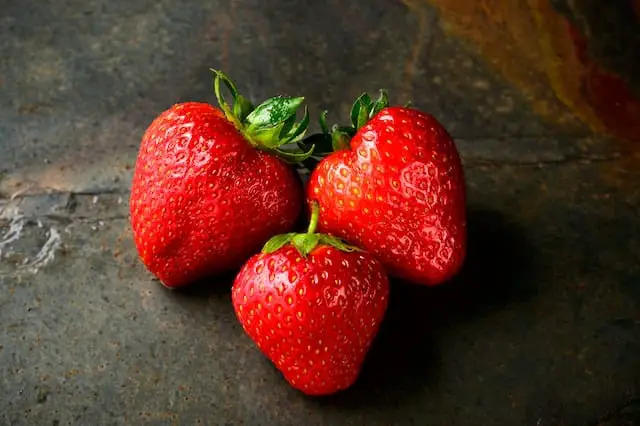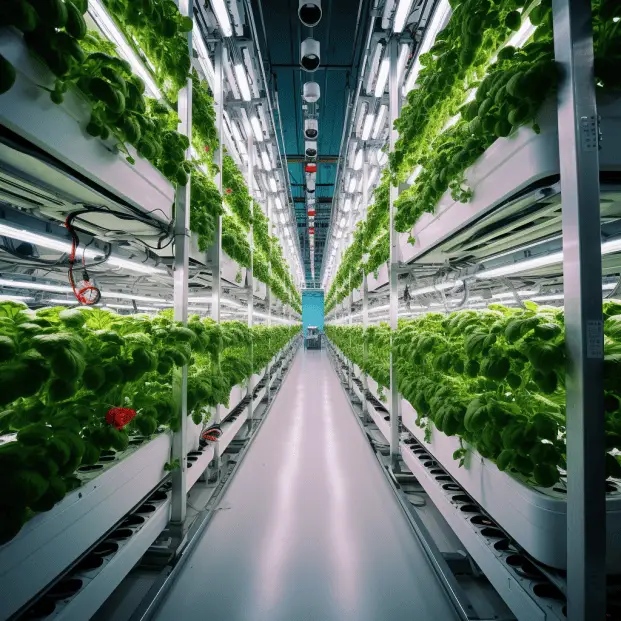Growing your own strawberries indoors seems impossible without fresh sunlight.
But hydroponics makes it easy to enjoy homegrown berries any time.
Some may think keeping hydroponic plants healthy indoors is hard, but with the right method, it’s simple.
Hydroponic gardening allows strawberry plants to thrive without soil. Instead, their roots stay immersed in nutrient-rich water.
This lets you control growing conditions like temperature, light, and moisture.
As an experienced gardener, I was thrilled to try hydroponic strawberries.
Through testing different set-ups, I found what strawberry plants need most.
Proper nutrients provide energy for maximum berry production. Adequate lighting stimulates growth similar to the sun’s natural rays.
Maintaining ideal moisture prevents dehydration which can halve your harvest. With these essentials handled, strawberries flourished indoors.
Before long, I enjoyed bowls bursting with my own sweet berries – even in winter!
Growing hydroponic strawberries does require attention, yet yields mouthwatering rewards.
Stick with my methods, and you’ll continuously savor fresh berries rivaling store-bought. Read on to learn secrets for reliable results in this growing guide.
Knowing these keys to success is crucial if you want to start growing and enjoy homemade strawberries whenever your heart desires!
KEY TAKEAWAY
How to grow hydroponic strawberries?
Select the Best Hydroponic Strawberry Varieties

Growing strawberries year-round sounds challenging. But with the right strawberry varieties and setup, it’s easy! (1) I’ve tried different types and found which works best.
Certain strawberry plants constantly bear fruit, not just once a summer. These day-neutral variety of strawberries are perfect for indoor garden.
I recommend Albion and Seascape strawberries. Albion produces huge, delicious strawberry fruit. While Seascape makes firm berries perfect for snacks.
Other standouts are Quinault with broad berries and highly productive Tribute.
Some varieties grow well in LED lighting.
But avoid June-bearing types that only crop once. Research which thrive in containers, not in-ground.
Success starts with healthy bare root or plug plants from reputable nurseries. I don’t advise starting from seeds since it delays berries.
When plants arrive, inspect for mushy or discolored roots. Give them low light for a few days before planting.
And don’t let roots dry out! With care, they’ll adapt fast and fruits follow.
Setups like deep water culture and nutrient film technique circulate air around strawberry roots.
This prevents issues better than a stagnant growing system. Materials like clay pebbles provide prime drainage, air and support versus rockwool.
Before planting, disinfect everything! Test equipment too for smooth operation. Then calibrate your nutrient levels just right.
By following these tips, your strawberries will thrive indoors anytime, all year long!
Control the pH Level Carefully When Growing Hydroponic Strawberry
Keeping your hydroponically grown strawberries happy is crucial to harvests of sweet berries.
One must-do is monitoring pH, the water’s acidity level. Strawberries only grow well in a narrow range between 5.5-6.5 pH.
Outside this zone, vital nutrients become scarce. Plants can’t take what they need to flourish.
When pH shifts too high or low, issues arise like poor growth and less fruits. That’s where fortunes change!
Experts recommend testing pH weekly using a precise digital meter. Pay attention to even slight changes.
When drift occurs, simple pH Up and Down solutions quickly return pH to normal. This ensures constant access to nutrients for plants to thrive.
University trials prove proper pH means big impacts! Plants grown at a low 4.5 pH setting yielded around 35% fewer berries than in the ideal range.
Steadiness there doubles yields and supersizes fruits!
Handling pH demands diligence like reading meters and making adjustments. Butpositive results come your way through larger harvests of sweeter berries.
Not a small reward for a small investment in pH care! Stick with keeping this key element steady. You’ll encounter nonstop picking powered by nutrition done right.
Proper Lighting and Temperature to Grow Hydroponic Strawberries
Growing strawberries requires precise conditions. University studies show what makes them thrive best. For juicy fruits, give plants plenty of bright light and warm temps.
During ripening, a minimum of 12-14 hours daily at 3000 lux intensity or higher fuels premium berry production.
High-output LED lamps provide complete, heat-free illumination. Amazingly, they create environments rivaling nature!
Daytime temperatures near 68°F with 61°F nights result in maximum yields of deeper red, sweeter tasting berries.
Any warmer or cooler can disrupt flowering, shape fruits oddly, or invite pests like gray mold.
To maintain such perfection, use thermostatically controlled heaters and AC units ventilated by exhaust fans.
This stable setting offers everything strawberry plants demand. They delightfully reward with magnificent harvests!
As for me, I witnessed firsthand how finely tuned growing conditions maximize nutritional density and flavor.
My strawberries shined like jewels too! With diligent tending, hydroponic growing allows enjoying sun-ripened berries indoors every day, no growing zone limits.
Thanks to the research, any gardener can revel in the ruby red rewards of strawberry nirvana.
Use the Right Hydroponic Nutrients for Strawberries
Last season, I noticed some of my strawberry plants weren’t thriving as well as the others. By testing the nutrient solution, I discovered it was deficient in calcium.
Since boosting the calcium levels, all my plants have taken off better than ever before. This experience reinforced how precisely controlling nutrients is key to maximizing yields.
Proper nutrients fuel big harvests of tasty berries. To grow strawberries, you need certain key elements more than other fruits.
They require generous amounts of potassium, phosphorus, calcium and magnesium especially.
Many pro gardeners begin with a balanced formula for young plants. Later they switch to one boosting flowers and fruits.
Following instructions prevents issues from too much feeding.
It’s wise checking EC and pH levels after each step to hit perfect numbers.
Companies like General Hydroponics systems offer complete lines tailored to growth stages. (2)
This ensures hydroponic strawberries get every nutrient advantage.
With the right help, they shine as picture-perfect producers. For myself, adopting tailored formulas revived a plant struggling before.
Its recovery blew me away with lush foliage and later, overflowing berries! Fine-tuning mixes unlocks the potential hiding within plants.
Now I understand not all nutrients are created equal. Some strawberries positively thrive on combinations brilliantly meeting demands.
Unlike traditional soil growing methods, hydroponics growing puts us in full control. With the ideal formula, your plants receive VIP treatment for sensational returns!
Be Careful With Pest Control When Growing Strawberries Hydroponically
When teaching others about hydroponic gardening, I emphasize how important controlling pests and diseases is to success.
In my years of cultivation, staying on top of scouting and any issues that arise early has allowed me to avoid serious problems.
Healthy plants aren’t stressed so they pour their energy into larger, more flavorful berries.
Pay close attention to temperature, humidity and air flow around roots. This discourages pests like spider mites and fungal diseases.
Scout plants regularly too for early signs of invasion.
Act swiftly at the first symptom spotted. For insects, remedies involve oils, soaps or employing helpers like ladybugs.
Fungi and bacteria demand timely, post-label use of selective fungicides. Always read and follow safety steps with any chemicals.
Regular cleanings disinfect gear, also lowering illness odds. Personally, remaining vigilant caught a powdery mildew outbreak in its beginnings.
A fast response with baking soda solution wiped it out, sparing my harvest. Early detection and quick action saved the day!
With diligence watching plants and swatting issues immediately, hydroponic systems stay in tip-top condition.
Maximum production results as stress-free strawberries do their thing making flawlessly ripe and red berries!
Simple maintenance builds better barriers against unwelcome visitors. Your hard work reaps sweeter rewards.
Pick Strawberries at the Right Time for Best Flavor

Knowing when berries ripen fully inside takes trial and error. Unlike fields, indoor plants won’t change colors signaling readiness.
Instead, gauge fruit size. As berries near three-quarters to full growth, start sampling.
Look for perfect sweetness and aroma in brightly red ones. Gentle handling prevents bruising that shortens edible shelf life.
Initially gauging ripeness proved tricky till I learned signs. Early attempts netted some underripe tart tastes.
But with each learning curve, success grew. Soon I instinctively recognized peak doneness down to the berry.
Fresh hydroponic strawberries shine stored in the fridge up to a refreshing 5-7 days.
My family delights in their crisp crunch and intense flavor thanks to efficient vertical growing methods.
Success comes from applying hard-earned wisdom and being patient throughout each season.
For those considering gardening indoors, these hydroponic systems provide rewarding lessons.
With practice, your harvests too will blow any berries in grocery aisles out the water!
I can’t wait for you to discover that prideful feeling upon eating nature’s treats nurtured by your own dedication.
Goes to show if I grew them, you definitely can too!
Growing Hydroponic Strawberries Can Yield Higher Quantity and Quality
Hydroponics as a growing medium opens rewarding doors. First, precise control lets you harvest year round despite region or season!
Indoor farming also exclude pests that often harm soil-grown plants.
This leads to more gorgeous, nutrient-packed fruits with better keeping quality too. As someone who has grown hydroponic strawberries for several seasons,
I can attest that yields far surpass soil gardening. In my systems, plants routinely produce over 2 pounds of berries each – well above the 1-1.5 pounds typical in soil.
Precise nutrient availability and optimized conditions unlock their full potential.
For myself, first attempts grew edible yet small strawberries. Switching to a drip system and customized nutrients took production to new highs.
Tall tales of hydroponic success inspired me for a reason – the proof lies within!
Since then, the sweet taste of achievement remains through each flavor-packed berry. No more excuses to quit fresh years round.
With the right approach, controlled environments and exacting methods deliver unbelievable results. Go ahead, discover why these words ring true!
Experimenting oneself transforms speculation to sweet reality. Your hydroponic strawberry garden awaits whenever inspiration strikes.
Begin your path to garden delights today – the bounties will far outweigh any efforts involved. After all, what could top nature’s gifts cultivated by our hands?
Frequently Asked Questions
How do I choose the best hydroponic system for strawberries?
There are several popular hydroponic systems for growing strawberries, including drip systems, nutrient film technique (NFT), deep water culture (DWC), and ebb and flow or flood and drain systems.
Key factors to consider include the size and layout of your growing area, desired level of involvement, and plant yield goals.
Reviews from other growers can also provide helpful insight on which systems have worked best for strawberry production and disease prevention. When choosing a system, be sure it allows for adequate watering and air pruning of the roots.
Can strawberries be grown from seed?
While it is possible to grow strawberries from seed, it is generally not recommended as the process takes much longer than using bare root plants or started plugs.
Strawberry seeds need time for germination and will not fruit until their second year. Many gardeners prefer to start with nursery transplants for an earlier harvest.
However, growing from seed can be a fun project and allows you to observe the entire growth cycle. Proper seed starting techniques like warmth and hydration help encourage germination.
What hydroponic nutrients are best for growing strawberries?
Strawberries have specific nutrient needs compared to other fruits.
They require higher amounts of potassium, phosphorus, calcium and magnesium to support robust plant growth and heavy fruit production.
Many experienced hydroponic gardeners use a balanced vegetable nutrient formula during the plant’s vegetative stage followed by a formula higher in phosphorus and potassium once flowering begins.
Leading brands like General Hydroponics FloraSeries offer tailored two-part formulas for different growth phases. Proper calibration and monitoring of pH and EC levels ensures optimal nutrient availability.
What pests and diseases commonly affect hydroponically grown strawberries?
Some potential issues to watch out for include spider mites, powdery mildew, gray mold (botrytis) and root rot.
Maintaining ideal temperatures, good air circulation around the roots, and sanitizing equipment can help prevent diseases.
Regular inspections allow for early detection and treatment. Natural remedies like neem oil or insecticidal soap work well against minor pest infestations.
For more serious problems, targeted organic or synthetic fungicides may be needed. Always read labels carefully and practice integrated pest management.
Prompt action at the first signs of stress can often eliminate concerns before major damage occurs.
Do hydroponically grown strawberries produce more yield than soil-grown?
Many university studies have shown hydroponically grown strawberries to have substantially higher yields than those grown in soil.
This is due to greater environmental control allowing optimal growing conditions year-round.
Research from the university of arizona found an average of over 2 pounds per plant, which is two to three times more than conventional soil yields.
The consistent supply of nutrients, oxygen to the root zone, and ideal temperature regulate factory fruit production.
With the right varieties, growing methods, and environmental parameters, hydroponics enables bountiful harvests of premium quality strawberries.
How can I pollinate my hydroponically grown strawberries?
Manual pollination is typically required for hydroponically grown strawberries since no pollinating insects are present.
When flowers first emerge and open, use a small paintbrush or cotton swab to gently transfer pollen between different flowers.
Make sure to pollinate in the morning for best results. Self-pollinating varieties may not need as much pollination assistance but it still helps maximize yields.
As an alternative, planting a mix of self-fruitful and self-sterile strawberry cultivars allows for natural cross-pollination among the plants.
Proper pollination leads to healthier, larger fruits and a longer harvest period.
Conclusion
Whether enjoying berries or tomatoes, growing hydroponically brings unending delight. By tending plants indoors, your green thumb blooms year-round too!
For strawberries, don’t forget keeping small varieties, ample lighting and stable temperatures. Give balanced nutrients also.
With care, rewards come through sweet homegrown fruits.
Yet this introduces only a glimpse. So much more awaits within hydroponics! In my next guide, tomatoes reveal exciting potential likewise.
By learning optimized cultivation methods, flavors intensify beyond any store-bought. Vibrant colors show nature’s gifts shining through controlled indoor environments.
Kits today simplify starting for all experience levels too. But the true magic lies within customized nurturing unlocking nature’s full potential.
Remain open and eager to gain wisdom from each crop. Their diverse lessons cultivate boundless creativity.
Together let’s continue exploring hydroponics endlessly. My hope remains empowering others to experience gardening bliss.
By supporting each other’s journeys, community satisfaction grows for all.
So don’t hesitate embarking on new adventures indoors! I can’t wait to see capabilities uncovered.
References
Related Articles
Was this helpful?

Crystal Erickson is an agriculture enthusiast and writer with a passion for sustainable farming practices and community development. Growing up on a family farm in rural Iowa, Crystal developed a love for the land and a deep appreciation for the hard work and dedication required to make a farm successful.
After completing a degree in Agriculture and Environmental Science from Iowa State University, Crystal began her career as an agricultural journalist, covering stories and issues related to modern farming practices, crop management, and livestock production. She quickly established herself as a respected voice in the industry, known for her insightful reporting and thoughtful analysis.
Over the years, Crystal has written for a variety of publications, including Farm Journal, Successful Farming, and Modern Farmer, as well as contributing to several academic journals focused on sustainable agriculture and community development. Her work has been recognized with numerous awards, including the Iowa Farm Bureau’s Young Farmer Achievement Award and the National Association of Farm Broadcasting’s Farm Broadcaster of the Year.


